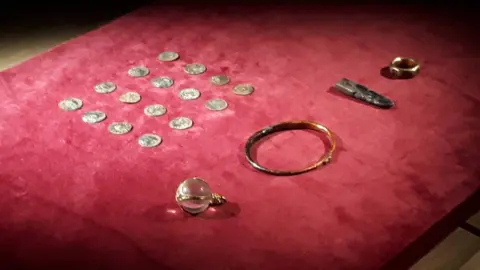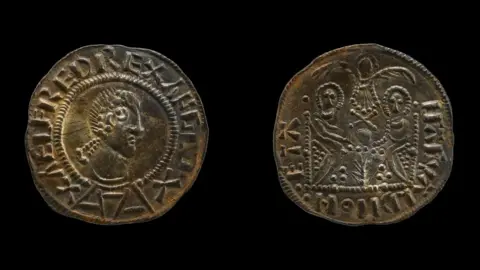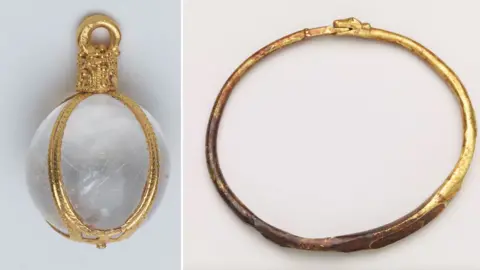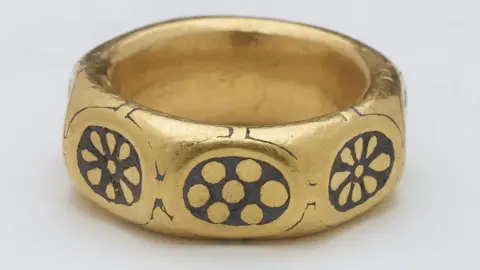How a treasure hunt led to a £3m 'heritage stealing'
 West Mercia Police
West Mercia Police"It's not a victimless crime, it's depriving us all of our heritage."
Those are the words used to describe the actions of two Welsh metal detectorists who have been found guilty of stealing one of the most valuable and historically significant treasure hoards in British history.
George Powell, 38, and Layton Davies, 51, found £3m worth of Anglo-Saxon and Viking treasure in Herefordshire, close to the Welsh border.
They should have declared the valuable coins but kept them for themselves.
A coin trader and antique seller were also convicted of their roles in the crime.
During a trial, Worcester Crown Court heard the four had ignored the law stating such finds must be properly declared in their bid to sell the items in small batches.
Among the haul were rare "double emperor" coins - estimated at £75,000 each - which feature Alfred the Great, who ruled from AD871, and another leader.
 British Museum
British MuseumThey also found Saxon coins, a 9th Century gold ring, a silver ingot and a 5th Century crystal sphere pendant.
One gold arm-ring could be a particularly significant Welsh discovery, according to Dr Gareth Williams, curator of early medieval coins at the British Museum.
"We don't have a direct parallel to this one and the find spot being in the Welsh borders is interesting, in that regard," he told BBC Wales.
"Is this straight forward Anglo-Saxon workmanship? Is it perhaps an early example of Welsh jewellery?
"More research is needed to really make sense of it."
Who was convicted?
- Layton Davies of Cardiff Road, Pontypridd, was found guilty of theft, conspiring to conceal criminal property and converting criminal property by selling it
- George Powell of Coulson Close, Newport, was found guilty of theft, conspiring to conceal criminal property and converting criminal property by selling it
- Simon Wicks, 57, of Hawks Road, Hailsham, was convicted of conspiring to conceal criminal property and converting criminal property by selling it
- Paul Wells, 60, of Newport Road, Cardiff, was found guilty of conspiring to conceal criminal property
 British Museum
British MuseumPowell and Davies found the jewellery and 300 coins in fields in the Welsh Marches in June 2015.
The court heard Davies was "amazed" and posted a picture of three of the coins on the web forum Detecting Wales.
Jurors heard he was an experienced detectorist, held a certificate for "best find in Wales" in 2014, and had been a member of various Welsh detecting clubs, including Detecting Wales, Gwent Detecting and Cardiff Scan Club.
He had previously donated more than 100 items to the National Museum Wales in Cardiff.
The court heard one archaeologist told the police he believed the treasure haul had been buried in one single, ancient, site and could even be Viking.
The artefacts were taken back to Wales to coin trader Wells, who had a stall at the Pumping Station antiques centre in Cardiff.
It was there it was agreed the coins would be taken to London, where antiques trader Wicks tried to sell them to the world renowned Mayfair auctioneers Dix Noonan and Webb.
Wicks took two batches of coins to the auctioneers.
Its expert said the coins were "extraordinary and very valuable", but was "suspicious".
 British Museum
British MuseumWicks admitted he sold several of the coins to his friend, who bought them in a deal at a service station, paying £28,000 in cash divided into three brown packets.
Wells was arrested after handing over five of the coins - which he had stitched into his leather glasses case - to a police officer.
The men should have declared the artefacts, a process overseen in England by the British Museum.
British Museum treasure registrar, Ian Richardson, carried out his own inquiries into the coins after hearing of the discovery.
He said: "I've been doing this job since 2007 and the number of cases of people being convicted for theft, which essentially derives from them not reporting their finds of treasure, has increased.
"It's not insignificant, it's not a victimless crime, it's depriving us all of our heritage."
Gwent Police's Amanda Blakeman is the National Police Chief's Council lead for Heritage and Cultural Crime, said: "I know that this is a historic find.
"It changes the course of history and also is a real indication of our commitment to ensuring that this type of crime that impacts so hugely on our communities and means so much to our heritage and our culture is detected.
"If we hadn't had been able to pursue it, to put the effort into the investigation... we wouldn't have been able to recover this significant piece of information that allows us to go back over history and to get a true version of events."
The men did declare the gold ring, crystal pendant and gold arm-band with the National Museum of Wales.
Wells told the court he was aware the men were in trouble when a global alert was issued online to coin collectors, warning them to stay away from undeclared treasure, "of extreme rarity", found in the Welsh Marches.
Many of the coins have still not been recovered.
